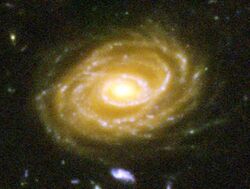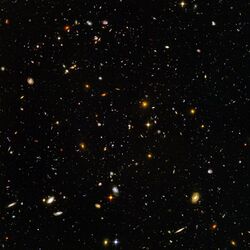Astronomy:UDF 423
From HandWiki
Short description: Distant spiral galaxy in the constellation Fornax
| UDF 423 | |
|---|---|
 Spiral galaxy UDF 423 in the Hubble Ultra Deep Field | |
| Observation data (J2000 epoch) | |
| Constellation | Fornax |
| Right ascension | 03h 32m 39.16s[1] |
| Declination | −27° 48′ 44.7″[1] |
| Redshift | 1 (or 0.46)[2] |
| Distance | 7.7 billion light-years (or 4.7 billion light-years) (light travel distance)[3] ~10 billion light-years (or 5.7 billion light-years) (present comoving distance)[3] |
| Apparent magnitude (V) | 20[1] |
| Characteristics | |
| Apparent size (V) | 0.11' x 5.04"[1] or 0.0027' x 0.0027' |

UDF 423 is the spiral galaxy in the lower right quadrant of the Hubble Ultra Deep Field.
UDF 423 is the Hubble Ultra Deep Field (UDF) identifier for a distant spiral galaxy. With an apparent magnitude of 20,[1] UDF 423 is one of the brightest galaxies in the HUDF and also has one of the largest apparent sizes in the HUDF.[1]
Distance measurements
The "distance" of a far away galaxy depends on how it is measured. With a redshift of 1,[2] light from this galaxy is estimated to have taken around 7.7 billion years to reach Earth.[3] However, since this galaxy is receding from Earth, the present comoving distance is estimated to be around 10 billion light-years away.[3] In context, Hubble is observing this galaxy as it appeared when the Universe was around 5.9 billion years old.[3]
See also
- List of Deep Fields
References
- ↑ 1.0 1.1 1.2 1.3 1.4 1.5 "UDF 423". Wikisky. http://www.wikisky.org/?ra=3.5442&de=-27.7907&zoom=12&show_grid=1&show_constellation_lines=1&show_constellation_boundaries=1&show_const_names=1&show_galaxies=1&show_box=1&box_ra=3.544208&box_de=-27.812397&box_width=50&box_height=50&img_source=IMG_all.
- ↑ 2.0 2.1 Sangeeta Malhotra. "As far as the Hubble can see". Arizona State University. http://malhotra.asu.edu/Welcome_files/ASY-HI1105.pdf.
- ↑ 3.0 3.1 3.2 3.3 3.4 Edward L. (Ned) Wright. "Cosmology Calculator I". Astronomy @ UCLA. http://www.astro.ucla.edu/~wright/CosmoCalc.html.
 |

